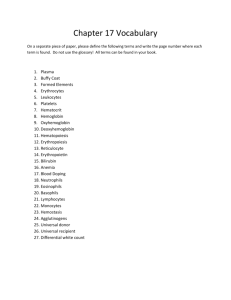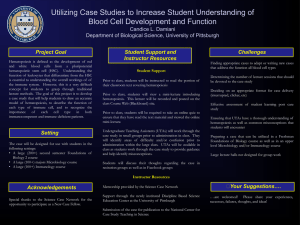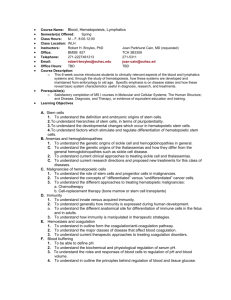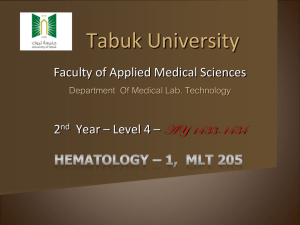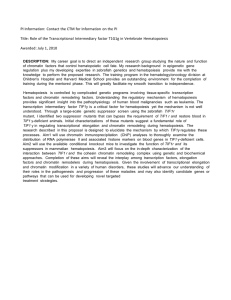blood cells and plasma
advertisement
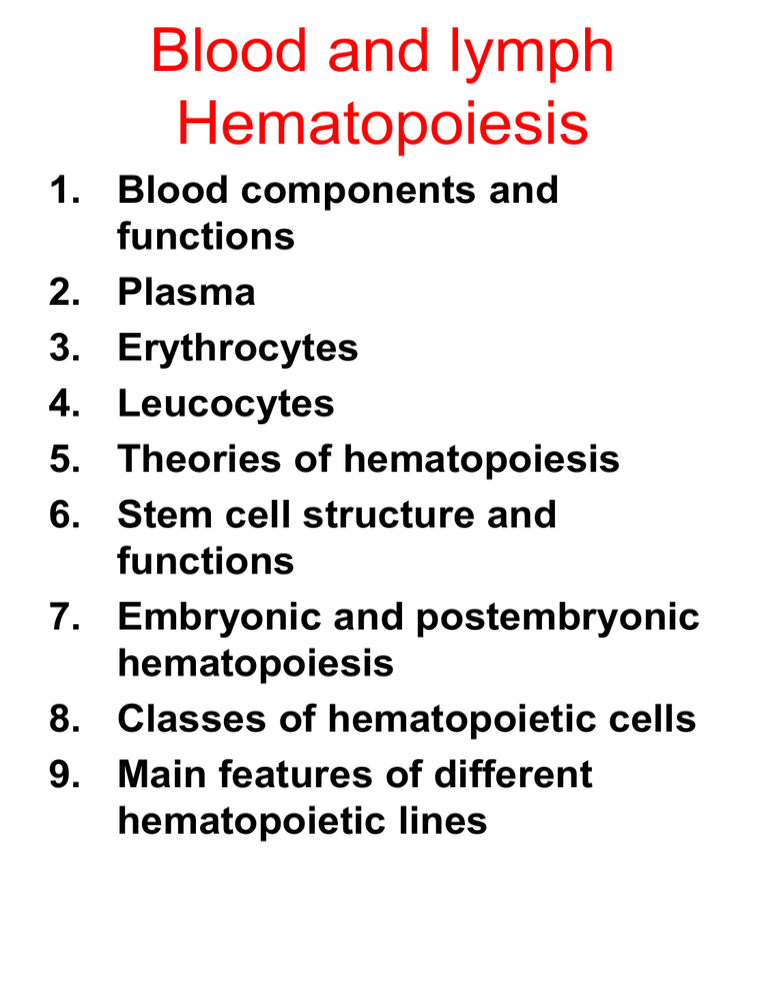
Blood and lymph Hematopoiesis 1. Blood components and functions 2. Plasma 3. Erythrocytes 4. Leucocytes 5. Theories of hematopoiesis 6. Stem cell structure and functions 7. Embryonic and postembryonic hematopoiesis 8. Classes of hematopoietic cells 9. Main features of different hematopoietic lines Tissues of inner environment 1. Blood and lymph 2. Connective tissues Blood functions Transport 1. Trophic 2. Respiration 3. Humoral 4. Excretion Protective Homeostatic Blood= cells + plasma (RBC+WBC+PL) hematocrit VFe/Vpl Plasma physical condition – colloid solution chemical composition: 90-93 % water 7-10 % dry residue (7% proteins; albumins 4%, globulins 1-3%, fibrinogen 0,2-0,4%) others 3% (enzymes, vitamins, salts, waste products…) pH 7,36 Hemogram (general blood analysis) Hematocrit 45:55 Erythrocytes men women 3,9-5,5 x 10 12/l 3,7-4,9 x 10 12/l Reticulocytes 2-10 per 1000 erythrocytes Hemoglobin men 130-160 g/l women 120-140 g/l Leucocytes 4-9 x 10 9/l Platelets 180-320 x 10 9/l Speed of blood sedimentation men 6-12 mm/hour women 2-14 mm/hour Erythrocytes Respiratory Transport Alkaline-acidic balance Group Sickle-cell anemia Discocytes, planocytes,echinocytes… Anisocytosis >20% abnormalshaped cells Normocyte 7,1-7,9 mkm (75%) Macrocyte >8 mkm Microcyte <6 mkm Poykilocytosis >25% abnormalsized cells Leucocytes Leucocytes count % Granulocytes Bazo Eosino philic philic 0-1 0.5-5 Agranulocytes Neutrophilic Band Juvenile Segmented 0.5- 1-6 1 47-72 Lymphocytes Mono cytes 19-37 3-11 Neutrophils Neutrophil Eosinophil Eosinophil Basophil Basophil Lymphocytes –immunocytes 1. Small, medium sized, large 2. EM: small light and dark, medium sized, B-plasma cells 3. T and B 4. Active and memory cells Lymphocyte Monocyte-mononuclear cell >20 mkm Bean-like nucleus Golgi apparatus =>lysosomes Active type - macrophage Monocyte Platelet HEMATOPOIESIS – blood components development (blood cells and plasma) Hematocytopoiesis: 1. Erythrocytopoiesis 2. Leucocytopoiesis a) granulocytopoiesis b) agranulocytopoiesis 3.Trombocytopoiesis THEORIES OF HEMATOPOIESIS • POLYPHYLETIC THEORY – each mature blood cell type is derived from its own distinct stem cell • MONOPHYLETIC THEORY (A.A. Maximov) – there is one stem cell, which can form all the mature blood cells types • Multipotential stem cell (CFU-S – colony-formingunit of spleen) Scheme of hematopoiesis Hematopoietic stem cell 1. Originates in the yolk sac 2. Thrives in RBM 3. Similar to small dark lymphocyte 4. Migrating cell 5. Pluripotential cell (gives rise to different cells) 6. Self-supporting cell 7. Rarely dividing cell (Go) 8. Sensitive cell Mononuclear macrophagic system Differences between embryonic and postembryonic hematopoiesis Embryonic Postembryonic Histogenesis of blood Blood physiologic regeneration Extracorporal (extraembryonic) Intracorporal Intravascular Extravascular Occurs in different organs Megaloblastic erythropoiesis mesoblastic RBM Normoblastic CLASSES OF HEMATOPOIETIC CELLS I class – polipotent (pluripotent) stem cell II class – hemistem cells for lymphocytopoiesis and myelopoiesis III class – unipotent cell (committed) sensitive to exact hemopoietin (erythropoietin, leykopoietin, thrombopoietin) IV class – blasts (young actively dividing cells) V class – maturing cells VI class – an “adult” mature cells in peripheral blood Erythropoiesis 1. Decrease in cell size (from 20 till 8 мm) 2. Ejection (extrusion) of the nucleus 3. Accumulation of hemoglobin in the cytoplasm 4. Basophily decrease and acidophily increase ERYTHROPOIESIS GRANULOCYTOPOIESIS GRANULOCYTOPOIESIS 1. Decrease in the cell size 2. Chromatin condensation 3. Changes in nuclear shape (flattening – indentation – lobulation). 4. Accumulation of cytoplasmic granules. LYMPHOCYTOPOIESIS LYMPHOCYTOPOIESIS 1. Begins in red bone marrow and then continues in lymphoid tissue 2. Lifespan varies in different types of lymphocytes 3. Antigenindependent development – in the central hematopoietic organs (red bone marrow and thymus) and antigendependent – in peripheral ones (spleen, lymph nodes and nodules) MONOCYTOPOIESIS 1. Decrease in cell diameter 2. Decrease in nuclear diameter 3. Cytoplasm basophily decreases 4. Nucleus changes its shape from round to kidney-like MONOCYTOPOIESIS Trombocytopoiesis Megakaryocyte

